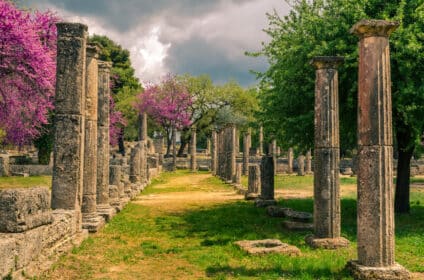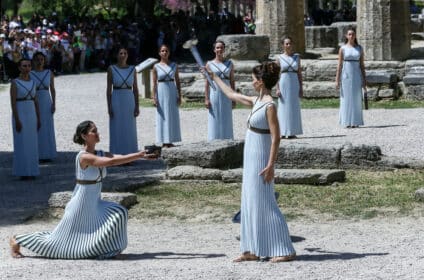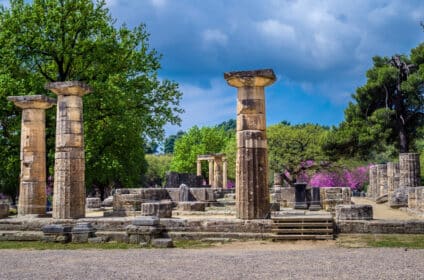Ancient Olympia
- Viewed - 410
Description
In western Peloponnese, in the beautiful valley of the Alpheios river, lies the most celebrated sanctuary of ancient Greece. Dedicated to Zeus, the father of the gods, it sprawls over the southwest foot of Mount Kronios, at the confluence of the Alpheios and the Kladeos rivers, in a lush, green landscape. Although secluded near the west coast of the Peloponnese, Olympia became the most important religious and athletic centre in Greece. Its fame rests upon the Olympic Games, the greatest national festival and a highly prestigious one world-wide, which was held every four years to honour Zeus.
The archaeological site of Olympia includes the sanctuary of Zeus and the many buildings erected around it, such as athletic premises used for the preparation and celebration of the Olympic Games, administrative buildings and other lay buildings and monuments. The Altis, the sacred enclosure and core of the sanctuary, with its temples, cult buildings and treasuries, occupies the centre of the site. It is surrounded by a peribolos, or enclosure wall, which in the late fourth century BC had three gates on its west side and two on the south, and is bordered on the east by the Echo Stoa, which separates the sacred precinct from the stadium.
The Classical Temple of Zeus and the earlier Temple of Hera dominate the Altis. East of the Heraion is the Metron, a temple dedicated to Cybele, the mother of the gods, and behind this, on the foot of Mount Kronios, a row of treasuries dedicated by Greek cities and colonies. To their west lies the Nymphaion, a splendid fountain dedicated by Herodes Atticus. South of the Heraion and over the remains of the prehistoric settlement of Olympia is the Pelopion, a funerary monument commemorating the hero Pelops. Also within the Altis are the Prytaneion, the see of the sanctuary officials, and the Philippeion, an elegant circular building dedicated by Philip II, king of Macedon. Southeast of the Heraion was the great altar of Zeus, a most important monument entirely made of ashes and therefore now completely lost. The remaining space inside the Altis was filled with numerous altars and statues of gods, heroes and Olympic winners dedicated by Greek cities or wealthy individuals, such as the Nike of Paionios
ADMINISTRATION SERVICE:
ANTIQUITY SERVICE OF PREFECTURE ILIA
Telephone: +302624022517
Fax: +302624022529
Email: efahle@culture.gr
TICKETS:
Full: €12, Reduced: €6
For the period April 1st – October 31st combined, individual ticket can be purchased for the price of 12 euros (reduced ticket € 6) and includes the visit to the following areas:1.Archaeological Site of Olympia, 2. Archaeological Museum of Olympia 3. Museum of the History of the Olympic Games of Antiquity and 4. Museum of the History of the Excavations in Olympia. The ticket is valid for one day. There are no longer availiable tickets only for a single area (e.g. The Arcaeological Site of Olympia)
Special ticket package: Full: €12, Reduced: €6
During the period November 1st – March 31st, the price of the single ticket for all the above mentioned sites is reduced by 50% for all visitors and cost 6 euros.
DISABLED SUPPORT:
The possibilities provided by the space for the disabled are: Paved routes so that the wheelchairs can be easily moved. Ramps (one at the SW entrance of Altea and one at the Crypt), ramps at the toilets and it is planned to place an information sign with the Braille system.
SOURCE: www.odysseus.culture.gr
ANTIQUITY SERVICE OF PREFECTURE ILIA
Gallery / Photos
Location / Contacts
- Address : Ancient Olympia
- Phone : +302624022517
- Mail : efahle@culture.gr
- Website : http://odysseus.culture.gr





